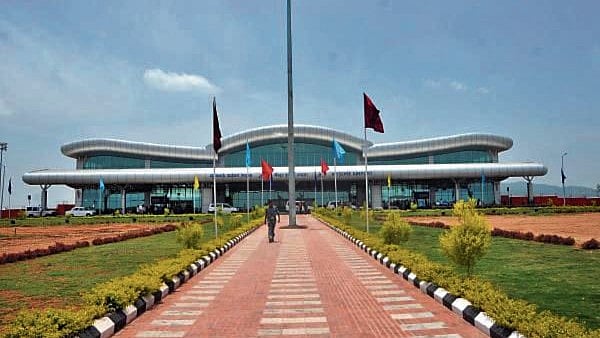
Mysuru Airport.
DH File Photo
The expansion of Mysuru Airport promises significant benefits for both the local population and surrounding regions. A key proposal is the extension of the runway from its current 1.7 km to 3.5 km, allowing the airport to accommodate larger, wide-body aircraft like the Boeing 777 and Airbus A350. This upgrade will enhance domestic and international connectivity.
The establishment of a dedicated cargo terminal at Mysuru Airport will be a game-changer for regional trade. It will facilitate the free movement of goods and agricultural produce, connecting local markets to international ones. For example, with a decline in Brazilian coffee production due to adverse weather, global demand for Kodagu coffee has increased. Expanded cargo facilities will help reduce production and logistics costs, benefiting both farmers and businesses. Additionally, the e-commerce sector will see smoother operations with more efficient cargo movement.
Growth opportunities
Tourism: A major driver of Mysuru’s economy, tourism will get a boost with the expansion of Mysuru Airport. In 2024, Mysuru attracted around 40 lakh tourists, a number expected to rise with improved airport infrastructure. Known for its rich heritage, the city will benefit from better connectivity, with taxis, cabs, and buses ensuring easy access to the airport.
Mysuru is already a key destination for yoga enthusiasts, and better air connectivity will make it more accessible for more visitors for yoga and wellness retreats. The government’s modified UDAN (Ude Desh ka Aam Nagrik) scheme, which aims to enhance regional connectivity to 120 new destinations, included Mysuru, further strengthening its position as a major tourist hub.
Economic growth: Mysuru’s economy is steadily growing, driven by tourism, manufacturing, and information technology. As the economy expands, the disposable income of its population, which is now over 13 lakh—a significant increase from the 2011 census. This growth is also boosting local demand for real estate, contributing to higher property prices due to supply-demand imbalances.
However, challenges such as high food inflation have impacted purchasing power. Demand-side factors, such as income transfer schemes for low-income households, also influence consumer spending patterns. Despite these challenges, Mysuru’s expanding economy has attracted foreign direct investment (FDI), with major industries, large companies, and retail brands looking to establish a presence in the city.
The airport expansion is also expected to ease passenger load at nearby airports, particularly at Bengaluru, by offering a more convenient and direct connection for travellers. Mysuru’s favourable weather and flat terrain allow for year-round operations of large aircraft like the Boeing 777 and Airbus A350. As a Tier-2 city, Mysuru will also serve neighbouring districts such as Kodagu, Chamarajanagar, Hassan, and Mandya, extending its reach across the region.
To complement the expansion of the airport, improvements in road infrastructure are essential. For instance, the Mysuru-Gundlupet National Highway (NH 766) should be widened to a four-lane highway, starting from Kalale Gate. The existing two-lane stretch experiences high-speed traffic and frequent overtaking, particularly due to the night traffic ban imposed in the Bandipur National Park, Mudumalai (Tamil Nadu), and Muthanga (Kerala) reserve forests. Expanding the highway will ease congestion and ensure smoother travel, especially for those relying on the improved airport and connectivity.
The expansion of Mysuru Airport holds immense potential for growth in trade, tourism, and overall economic development in the region. By improving cargo handling facilities, tourism infrastructure, and connectivity, it will attract more visitors, businesses, and investment to Mysuru. Coupled with the proposed improvements in road infrastructure, this will pave the way for Mysuru to become a major economic and transportation hub in South India.
(The writer is an economist)
